78th Newsletter
Newsletter Content
- Introduction
- Health in an Ageing Society
- MyoFit46 Update
- Insight 46 Update
- COVID-19 Longitudinal Health and Wellbeing National Core Study
- The Garmin Watch
- Online Cognitive Testing
- Home Visit 2023-24
- ‘Secondary Education and Social Change in the United Kingdom since 1945’ (SESC) project
- Overview of the recent data collections
Happy Birthday
It has been another busy, yet exciting year for the study.
Over the last year nurses from Inuvi (one of our field work partners) have been touring the country collecting data as part of the home visit. Thank you to everyone who responded, the response has
been very positive. We are in the process of finalising the dataset so that we can start to analyse it.
The MyoFit46 one day clinical sub-study, looking at the heart, has nearly finished clinic visits and the data analysis has started. Thank you to everyone who participated. One of the pieces of equipment used for this study was a specially designed vest. Initial findings from this vest have shown that it has the potential to be used in standard care as it is re-usable and time-efficient to use. Dr Gaby Captur is working to get this manufactured for wider use.
For the forthcoming year, we will be continuing to see people for Insight 46, the neuroimaging substudy and more information about this study can be found on page 4. We will also be continuing recruitment for the Garmin watches and more information can be found on page 6.
Soon, we will be hosting a series of events across the country – this will be an opportunity to meet you in person, provide face to face support to those of you who have been invited to wear a Garmin watch and share with you our latest findings, as well as saying ‘Thank you’. If you have registered to attend but have not received confirmation, please get in touch.
I am pleased to announce that we have been successful in obtaining funding for the NSHD
from the Medical Research Council (MRC) for the next 5 years. As part of this work, we will be integrating some of our activities with the Centre for Longitudinal Studies (CLS) at UCL, who houses the successive UK Birth Cohorts. We have always worked closely with CLS and we are looking forward to cementing our scientific partnership. The MRC has funded the study since 1962 and we are delighted that they will continue their support.
I wish you all the best for 2024 and thank you for continuing to be part of the NSHD. Your time and commitment to the study are greatly appreciated.
Nish Chaturvedi
Director of the NSHD
Health in an Ageing Society
Each year, the Chief Medical Officer for England, Professor Chris Whitty, publishes a report on a topic that he considers important. For 2023, he focused on health in an ageing society. The report gathered lots of information from cohort studies, including NSHD. While we are all living longer, the overall message focused on the factors that lead to later years being spent in better physical and mental health. Important topics were reducing frailty and ill-health and adapting the environment to help those with disabilities lead independent and enjoyable lives.
In the 2022 postal questionnaire we asked about medical conditions which had been recently diagnosed. We found that having more than one long-term condition had become more common between the age of 70 to 76. Long-term conditions are health problems can be managed by drugs, but for which there is no cure, for example high blood pressure, diabetes, arthritis and angina. We also found that NSHD study members are healthier than the general population (on average they have one fewer diagnosis). From the postal questionnaire, 50% of study members had two long-term conditions, and 25% had three or more. The report suggested moving away from having to see several specialists and move towards training more general health professionals who could manage a combination of complex illnesses at the same time.
Despite many negative portrayals of ageing, the report emphasised that many people enter their mid-70s healthy enough to do what is important to them. This matches findings from the 2022 postal questionnaire, showing that only 10% of study members are classed as living with frailty, where people are slower, weaker, or need physical help. In contrast, 86% can still do housework and 94% manage the washing-up!
The report identified differences in the availability of services as more older people move out of urban areas. Many of these areas are often beautiful and welcoming but don’t have the same health care services. More rural settings also tend to have less public transport and fewer services which have been specifically designed for older adults, including housing. People who have moved to new areas in later life often do not have the social support networks, such as friends and families living close by, compared with those who have remained in the same area.
Finally, Professor Whitty called for more research into how we could delay the start of disease and frailty, so that everyone can have a good quality of life. Older age and illness shouldn’t be reasons to exclude people from research studies. We want to study everyone, not just those in good health. That is why we invite everyone to participate regardless of health status. However, we are trying different methods to collect data, including linking to information from GPs and hospitals. This limits the impact on the study members and the need to travel to a clinic location. Together, health professionals and researchers will continue to learn from studies like NSHD for current and future generations.
MyoFit46 Update
The MyoFit46 sub-study is interested in looking at ways to maintain heart health as we age. The study aims to do this by using cutting-edge cardiac MRI and heart rhythm approaches.
Thank you to everyone who has taken part! Recruitment has nearly finished, and we are expecting to have completed 500 visits by the end of March.
We have started the data analysis and made some surprising findings about the aorta’s response to adenosine stress. The aorta is the largest artery in body and carries blood from the heart to the rest of the body.
Adenosine is a drug which stimulates the heart, similar to what happens when you exercise, and this was given to the participants just before the heart was scanned. We have discovered that healthy aortas are able to react to the additional stress caused by the adenosine and maintain their shape, while unhealthy aortas are more likely to expand. We will explore the reasons for this in order to learn how to preserve healthy aortas.
In addition, we can now understand how scar or inflammation in the heart muscle wall impacts on its electrical properties. We can do this as we have developed a new vest which sits across the whole chest and is able to collect electrical signal from different parts of the heart. This allows us to see your heart’s electrical signals in unprecedented detail.
Look at what you have helped us invent!
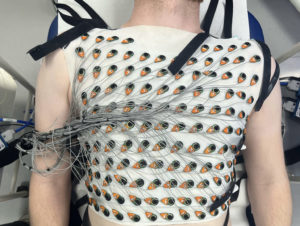
Data from the MyoFit46 Clinic has been used to make a vest that has the potential to save millions of lives. The vest is able to identify people with abnormally fast heart rates, who have a higher risk of having a heart attack. This vest is now being applied to NHS patients suffering from heart conditions.
Insight 46 Update
Insight 46 Update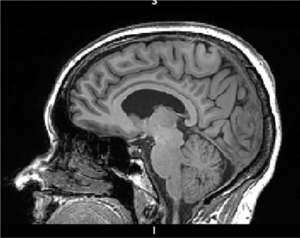
In 2015 we started a neuroimaging sub-study, called Insight 46. The aim of the study was to gain a better understanding of how the brain changes as we age. We are using MRI scanners to get detailed images of the brain. The study also involves tests of memory and thinking, physical assessments, and cardiovascular measures. We will combine all of this information to look for changes in the brain that affects memory and thinking. The ultimate goal is to see if we can spot early changes in the brain that may lead to dementia. The first two waves included 502 study members, who had clinic visits roughly 2 years apart. In late 2021 we started the third wave of this data collection, which will be running to 2026.
The study involves a trip to London for two days of testing, including an MRI brain scan. We are using specialist equipment and scanners which means it is not possible to run the study in local hospitals. We are aiming to recruit between 650 to 700 for this third wave of the study. Thank you if you have already taken part.
We are continuing to invite study members from across the country. We recognise that it might not always be possible for everyone to come to London for these tests. However, we want to make sure everyone has the chance to take part. If you receive an invite, please do consider signing up if you able to do so.
The data collected from the first 3 waves of the Insight 46 research visits is having a large impact. We have published more than 30 papers. Some research highlights from the last year include:
Being physically active is important for healthy brain function.
Work led by Dr Sarah James found that being even moderately physically active at any time during adulthood was associated with higher scores on cognitive tests at age 69. The greatest positive cognitive effects were for those study members who were active throughout adulthood. These results show that starting physical activity early in life and staying active is beneficial to brain health and cognition.
Relationship between age of menopause and cognition.
PhD Student Lousia Needham looked at how the age of onset of menopause related to cognitive performance at the age of 70. She found that women who experienced the onset of menopause later in life performed better on some tests of memory and visual processing. The results also reinforced a previous finding that cognition during childhood is an important contributor to cognitive performance later in life.
Using machine learning to predict brain age
The NSHD provides a very special and unique opportunity to make comparisons between a person’s chronological age (that is, their “real” age based on their birth date) and their predicted “brain age”. Dr Aaron Wagen and UCL colleagues used machine learning computer techniques to estimate a person’s “brain age”. They found that men tended to have “older” brains than women of the same chronological age. They also found that study members with worse cardiovascular health at age 36 had a higher brain age later in life, and that a higher brain age was associated with slightly worse scores on cognitive tests. These results support previous findings that heart health during midlife is important to a healthy brain later in life. Future work will involve combining the data collected in Insight 46 and MyoFit46 sub-studies, to look at the links between brain and heart health.
 COVID-19 Longitudinal Health and Wellbeing National Core Study
COVID-19 Longitudinal Health and Wellbeing National Core Study
During the course of the COVID pandemic, the NSHD joined forces with other British Longitudinal Populations studies to create the Longitudinal Health and Wellbeing National Core Study, led by Prof Nish Chaturvedi. We each sent out similar questionnaires and the data were combined. This meant we could look at the effect of COVID across the country and across different age groups.
The research covered a wide range of topics, all important for understanding the pandemic, how to deal with its effects and to inform policy makers. The following are some of the key findings:
Getting to Grips with Long COVID
One of the important research areas has been Long COVID. Information from the questionnaires and GP records has helped to find out how common Long COVID is, what puts people at risk of it, and what the long-term effects might be. We also found that the way doctors record Long COVID cases can vary a lot. This finding has led to increased training to improve how the NHS tracks and manages these cases.
Mental Health Matters
We also looked at how our mental health before the pandemic affected how we coped with things like lockdowns. We studied the impact of big Government decisions, on our overall well-being. Using data from studies like NSHD, with lots of pre-pandemic data, was vital to understanding the true effects of the pandemic on our mental health.
Disruptions to Healthcare
There were difference on how the pandemic affected different groups of people. We have been looking at why some people were more likely to have issues in accessing healthcare, such as getting hold of medications or hospital appointments being cancelled. This is important for making sure our healthcare system can be better prepared, in case of future crises.
Vaccines: The Bigger Picture
We were interested in understanding how best to roll out vaccinations, ensuring they were safe and effective. The research showed that booster shots were essential to keeping our immunity strong against COVID-19.
Improving Treatment with Data
Lastly, the researchers have shown how quickly and effectively we can use data to monitor new treatments, which helped inform NHS guidelines. This approach could be a game-changer in rapidly understanding how well treatments work.
The COVID work has shown the importance of working with other groups and combining data. Most of the findings would not have been possible if we had worked alone. The COVID findings were written into cabinet reports and given to SAGE (Scientific Advisory Group for Emergencies). SAGE provided the Government with scientific and technical advice to support their decisions during an emergency.
The Garmin Watch
Sleep, movement, fitness, physical and mental health are all connected in ways not fully understood. Data collected over the years from home and clinic visits have been useful to understand what impacts our health. However, since these data are usually collected on a single day, ithey can only provides just a snapshot of a person’s health and may not fully represent them.
Life is made of ups and downs. Our physical and mental health changes over time and we are affected by many different things and seasonal variations. By monitoring these changes over time, we hope to provide valuable insights into how our bodies and minds work and this will help unlock the interactions between health, sleep and activity.
Recent technological advances have now made capturing daily changes possible. Wearable data does not contain personal or sensitive information (such as names or contact details) and is collected using a system that ensures data security and confidentiality. It is processed in a highly secure computing system (“Trusted Research Environment”), so it can not be linked back to any individual.
What do we measure?
We are asking study members to use a smart watch (Garmin Venu 2) and to install an application on their mobile phone (Radar Base), which we use to seamlessly collect data.
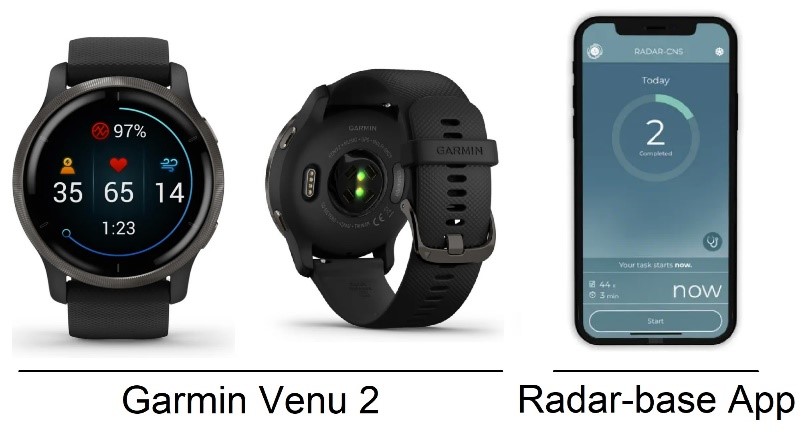
A summary of the data we are collecting is shown below:
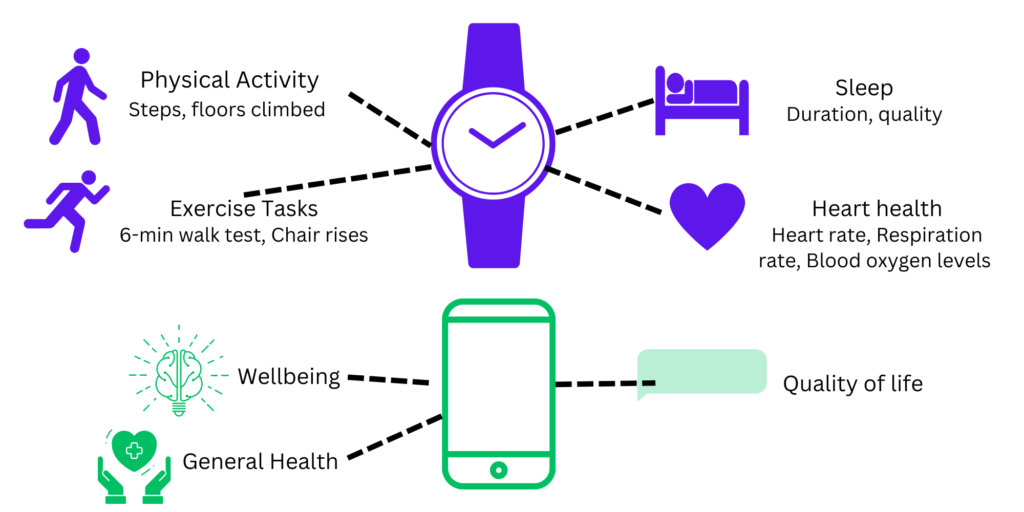
We started to invite study members to wear this watch in February 2023 and recruitment is still on-going. Thank you to everyone who has taken part so far.
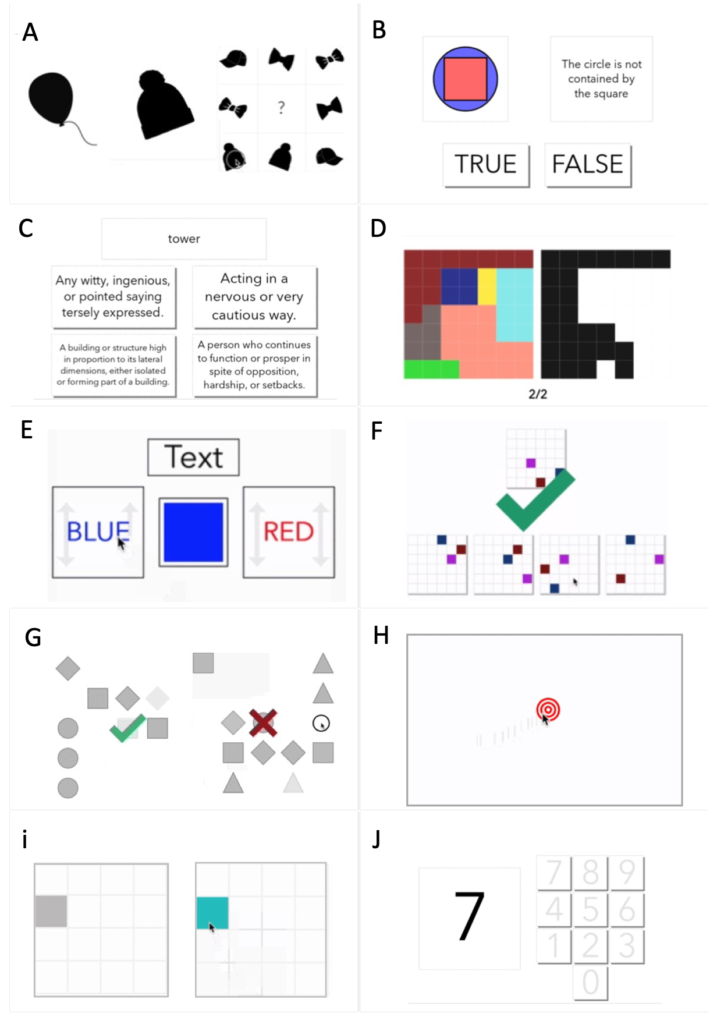 Online Cognitive Testing
Online Cognitive Testing
In the summer of 2023, we sent out email invitations to study members who we knew had an email address, inviting you to participate in a series of online memory and thinking tests from the ‘Cognitron’ battery of tests. We asked you to complete the tests at home, in your own time, using your own computer or tablet. This was done in collaboration with our colleagues at Imperial College London.
A total of 813 study members took part in the study. Thank you to everyone who participated and contacted us to provide your feedback on the tests.
We are combining the data from these online tests with the rich life course information from the previous NSHD data collections. This will help us to have a better understanding of the links between physical and cognitive health.
One aim is to see how these online tests compare against our standard in-person memory and thinking tests. Study members who took part in Insight 46, the neuroimaging sub-study of NSHD, completed a number of traditional memory and thinking tests, that are often considered as the gold-standard. When we compared the online tests to these in-person tests, we found that the tests gave similar results. We also found a link between the performance on the online tests and the measures of brain health from other assessments completed during the Insight 46 visit. This means that the tests could be used to track the brain ageing progress.
Once again, thank you for being a crucial part of our research community. We appreciate your time and support.
Home Visit 2023-24
Thank you to everyone to took part in the home visit!!
The home visits are now complete and we have started the process to clean the data, ready for analysis.
We have received a lot of feedback about the 6-day phone call. We appreciate remembering a list of 15 random words after 6-days can be challenging and we are sorry if this caused some distress. The reason for doing the 6 day recall is that the kind of memory tests we use typically test recall after a short delay, usually minutes. However, information learned normally can be forgotten over a longer period of days or weeks. This is called accelerated forgetting.
We also had several comments that study members could not remember the 15 words, but could remember the address or the 3 words given as part of the iPad test. The reason for this could be that three words are easier to remember than 15. In a famous 1956 article, the psychologist George Miller found that we can hold 7 items plus or minus 2 in short term memory. Fifteen words clearly exceeds the 9 outer limit of this. Miller may also have had the answer to why it’s easier to remember an address than random words, since he also argued that information can be more easily remembered as an item if it is ‘chunked”, i.e. where small pieces of a set of information are bound together to create a meaningful whole.
We also received a lot of positive comments and feedback about the nurses. These have been passed on and they were greatly appreciated. The nurses have also enjoyed their time on the study and chatting with all those they met.
‘Secondary Education and Social Change in the United Kingdom since 1945’ (SESC) project
The ‘Secondary Education and Social Change in the United Kingdom since 1945’ (SESC) project has been using qualitative material from the NSHD to research ordinary people’s experiences of secondary education in the UK in the postwar period. The team is made of social and cultural historians based in Cambridge and Paris, and the project has been funded by the ESRC (Economic and Social Research Council) since 2017. Alongside material from the birth cohorts (1958 and 1970 as well as 1946), they have been using school archives, sociological studies, and oral histories. During the COVID pandemic, when archives were less accessible, they devoted their energies to working with a group of current history schoolteachers to create a series of ‘resource packs’ for the KS3 history classroom. These packs use their research and sources to enable teachers to design lessons about social change in the UK since 1945 (gender, sexuality, social class, race and ethnicity), with the history of their own school as its basis.
They are now beginning to write up a final book, drawing together all the findings from the project to tell this ‘bottom-up’ history of everyday life in UK schools, from parents’ and pupils’ perspectives.
In 2023 they published two journal articles using NSHD data. The first explains their methodological approach to the NSHD data, how we combined qualitative and quantitative elements to write ‘pen portraits’ of study members’ lives, and how this can enrich understandings of postwar social mobility in Britain. The second focuses more closely on British women who attended secondary modern schools in the 1950s and 1960s, and explores their experiences and frustrations related to education and paid work up to the early 1970s. Both articles are available to read ‘open access’ online, using the below links.
Learn more about our project at our website, here: https://sesc.hist.cam.ac.uk/ Contact: Dr Laura Carter, Université Paris Cité, laura.carter@u-paris.fr Methodological article: https://doi.org/10.1080/13645579.2023.2218234 Secondary modern women article: https://doi.org/10.1093/tcbh/hwad048
KS3 resource packs for school history teachers: https://www.history.org.uk/secondary/categories/363/module/8773/secondary-education-and-social-change-in-the-uk-si